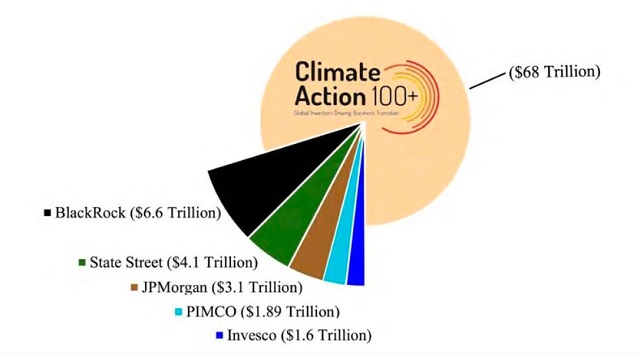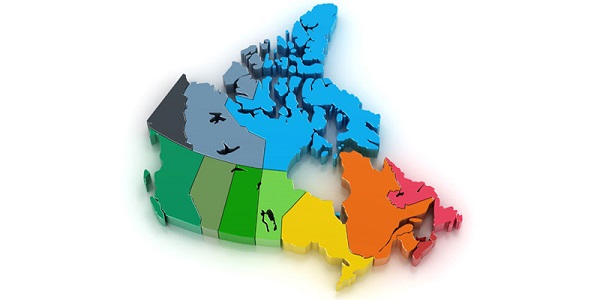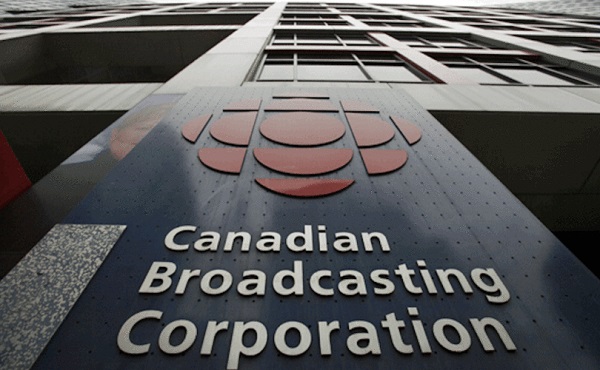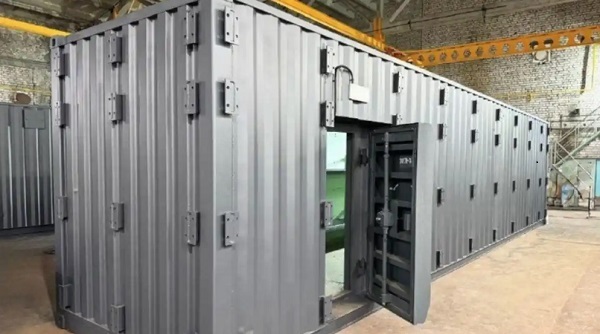Business
North Carolina-headquartered Barings named in Climate Action 100+ probe

The Judiciary Committee of the U.S. House of Representatives, in a report, says its probe has led to a loss of $17 trillion worth of assets under management by the Climate Action 100+. That includes $6.6 trillion from BlackRock, $4.1 trillion by State Street, $3.1 trillion by JPMorgan, $1.89 trillion by PIMCO, and $1.6 trillion by Invesco.
From The Center Square
By Alan Wooten
An interim report by the Judiciary – Climate Control: Exposing the Decarbonization Collusion in Environmental, Social and Governance (ESG) Investing – labels the initiative a “climate cartel,” one which is involved in collusion and has not been investigated by the Biden administration.
One North Carolina company is among more than 130 in the United States being asked by a congressional committee about involvement with environmental, social and governance initiative Climate Action 100+.
U.S. Reps. Deborah Ross and Dan Bishop, a Democrat and Republican respectively from North Carolina, are among the 42 members of the Judiciary Committee in the House of Representatives seeking answers. In addition to the letter sent to Charlotte-headquartered Barings, the probe also seeks answers on involvement by retirement systems and government pension programs.
The probe and letters dated last Tuesday to Climate Action 100+ is trying to find answers to how the companies are operating with tactics, requests and actions; and garner documentations. A noon Aug. 13 deadline is set for responses.
Antitrust law, and the possible breach of it, is cited in each letter. Antitrust laws, the Department of Justice says, “prohibit anticompetitive conduct and mergers that deprive American consumers, taxpayers, and workers of the benefits of competition.”
An interim report by the Judiciary – Climate Control: Exposing the Decarbonization Collusion in Environmental, Social and Governance (ESG) Investing – labels the initiative a “climate cartel,” one which is involved in collusion and has not been investigated by the Biden administration.
“The climate cartel has declared war on our way of life, escalating its attacks on free markets and demanding that companies slash output of the critical products and services that allow Americans to drive, fly, and eat,” the report says. “The Biden administration has failed to act upon the climate cartel’s apparent violations of longstanding U.S. antitrust law. The committee, in contrast, is actively investigating their anticompetitive behavior.”
The report says with launch of the probe came withdrawals from the effort by BlackRock, State Street and JPAM, “three of the world’s largest asset managers.” Asset managers BlackRock, State Street and Vanguard own 21.9% of shares, and vote 24.9% of the shares, within the Standard and Poor’s (S&P) 500.
More than 272,000 documents and 2.5 million pages of nonpublic information were reviewed, the Judiciary says.
Most of the letters went to addresses in New York, Massachusetts and California.
Barings, according to its website, “is a global asset management firm which seeks to deliver excess returns across public and private markets in fixed income, real assets and capital solutions.”
In general, ESG investing – an acronym used in conjunction with environmental, social, and governance policies in investments – measures company policy. These policies typically align with progressive, or left, thoughts when it comes to politics.
Other names of description are sustainability, such as treatment of natural resources, gas emissions and climate regulations. A company’s policies for profits shared in the community, and how health and safety are impacted, relates to the social aspect. Governance usually aligns not only with integrity of accountability toward shareholders, but also diversity in leadership.
Issues in a company’s industry and the principles of ESG often shape policy.
Bishop is a member of the Subcommittee on the Administrative State, Regulatory Reform, and Antitrust within the Judiciary Committee. The 26-member subcommittee is chaired by Rep. Thomas Massie, R-Ky.
Managing Editor
Business
Broken ‘equalization’ program bad for all provinces

From the Fraser Institute
By Alex Whalen and Tegan Hill
Back in the summer at a meeting in Halifax, several provincial premiers discussed a lawsuit meant to force the federal government to make changes to Canada’s equalization program. The suit—filed by Newfoundland and Labrador and backed by British Columbia, Saskatchewan and Alberta—effectively argues that the current formula isn’t fair. But while the question of “fairness” can be subjective, its clear the equalization program is broken.
In theory, the program equalizes the ability of provinces to deliver reasonably comparable services at a reasonably comparable level of taxation. Any province’s ability to pay is based on its “fiscal capacity”—that is, its ability to raise revenue.
This year, equalization payments will total a projected $25.3 billion with all provinces except B.C., Alberta and Saskatchewan to receive some money. Whether due to higher incomes, higher employment or other factors, these three provinces have a greater ability to collect government revenue so they will not receive equalization.
However, contrary to the intent of the program, as recently as 2021, equalization program costs increased despite a decline in the fiscal capacity of oil-producing provinces such as Alberta, Saskatchewan, and Newfoundland and Labrador. In other words, the fiscal capacity gap among provinces was shrinking, yet recipient provinces still received a larger equalization payment.
Why? Because a “fixed-growth rule,” introduced by the Harper government in 2009, ensures that payments grow roughly in line with the economy—even if the gap between richer and poorer provinces shrinks. The result? Total equalization payments (before adjusting for inflation) increased by 19 per cent between 2015/16 and 2020/21 despite the gap in fiscal capacities between provinces shrinking during this time.
Moreover, the structure of the equalization program is also causing problems, even for recipient provinces, because it generates strong disincentives to natural resource development and the resulting economic growth because the program “claws back” equalization dollars when provinces raise revenue from natural resource development. Despite some changes to reduce this problem, one study estimated that a recipient province wishing to increase its natural resource revenues by a modest 10 per cent could face up to a 97 per cent claw back in equalization payments.
Put simply, provinces that generally do not receive equalization such as Alberta, B.C. and Saskatchewan have been punished for developing their resources, whereas recipient provinces such as Quebec and in the Maritimes have been rewarded for not developing theirs.
Finally, the current program design also encourages recipient provinces to maintain high personal and business income tax rates. While higher tax rates can reduce the incentive to work, invest and be productive, they also raise the national standard average tax rate, which is used in the equalization allocation formula. Therefore, provinces are incentivized to maintain high and economically damaging tax rates to maximize equalization payments.
Unless premiers push for reforms that will improve economic incentives and contain program costs, all provinces—recipient and non-recipient—will suffer the consequences.
Authors:
Alberta
Alberta’s fiscal update projects budget surplus, but fiscal fortunes could quickly turn

From the Fraser Institute
By Tegan Hill
According to the recent mid-year update tabled Thursday, the Smith government projects a $4.6 billion surplus in 2024/25, up from the $2.9 billion surplus projected just a few months ago. Despite the good news, Premier Smith must reduce spending to avoid budget deficits.
The fiscal update projects resource revenue of $20.3 billion in 2024/25. Today’s relatively high—but very volatile—resource revenue (including oil and gas royalties) is helping finance today’s spending and maintain a balanced budget. But it will not last forever.
For perspective, in just the last decade the Alberta government’s annual resource revenue has been as low as $2.8 billion (2015/16) and as high as $25.2 billion (2022/23).
And while the resource revenue rollercoaster is currently in Alberta’s favor, Finance Minister Nate Horner acknowledges that “risks are on the rise” as oil prices have dropped considerably and forecasters are projecting downward pressure on prices—all of which impacts resource revenue.
In fact, the government’s own estimates show a $1 change in oil prices results in an estimated $630 million revenue swing. So while the Smith government plans to maintain a surplus in 2024/25, a small change in oil prices could quickly plunge Alberta back into deficit. Premier Smith has warned that her government may fall into a budget deficit this fiscal year.
This should come as no surprise. Alberta’s been on the resource revenue rollercoaster for decades. Successive governments have increased spending during the good times of high resource revenue, but failed to rein in spending when resource revenues fell.
Previous research has shown that, in Alberta, a $1 increase in resource revenue is associated with an estimated 56-cent increase in program spending the following fiscal year (on a per-person, inflation-adjusted basis). However, a decline in resource revenue is not similarly associated with a reduction in program spending. This pattern has led to historically high levels of government spending—and budget deficits—even in more recent years.
Consider this: If this fiscal year the Smith government received an average level of resource revenue (based on levels over the last 10 years), it would receive approximately $13,000 per Albertan. Yet the government plans to spend nearly $15,000 per Albertan this fiscal year (after adjusting for inflation). That’s a huge gap of roughly $2,000—and it means the government is continuing to take big risks with the provincial budget.
Of course, if the government falls back into deficit there are implications for everyday Albertans.
When the government runs a deficit, it accumulates debt, which Albertans must pay to service. In 2024/25, the government’s debt interest payments will cost each Albertan nearly $650. That’s largely because, despite running surpluses over the last few years, Albertans are still paying for debt accumulated during the most recent string of deficits from 2008/09 to 2020/21 (excluding 2014/15), which only ended when the government enjoyed an unexpected windfall in resource revenue in 2021/22.
According to Thursday’s mid-year fiscal update, Alberta’s finances continue to be at risk. To avoid deficits, the Smith government should meaningfully reduce spending so that it’s aligned with more reliable, stable levels of revenue.
Author:
-

 ESG2 days ago
ESG2 days agoCan’t afford Rent? Groceries for your kids? Trudeau says suck it up and pay the tax!
-

 John Stossel2 days ago
John Stossel2 days agoGreen Energy Needs Minerals, Yet America Blocks New Mines
-

 Daily Caller2 days ago
Daily Caller2 days agoLos Angeles Passes ‘Sanctuary City’ Ordinance In Wake Of Trump’s Deportation Plan
-

 Alberta2 days ago
Alberta2 days agoProvince considering new Red Deer River reservoir east of Red Deer
-

 Addictions2 days ago
Addictions2 days agoBC Addictions Expert Questions Ties Between Safer Supply Advocates and For-Profit Companies
-

 Aristotle Foundation1 day ago
Aristotle Foundation1 day agoToronto cancels history, again: The irony and injustice of renaming Yonge-Dundas Square to Sankofa Square
-

 Business16 hours ago
Business16 hours agoCBC’s business model is trapped in a very dark place
-

 conflict2 days ago
conflict2 days agoPutin Launches Mass-Production of Nuclear Shelters for his People






